Related Research Articles

Star formation is the process by which dense regions within molecular clouds in interstellar space, sometimes referred to as "stellar nurseries" or "star-forming regions", collapse and form stars. As a branch of astronomy, star formation includes the study of the interstellar medium (ISM) and giant molecular clouds (GMC) as precursors to the star formation process, and the study of protostars and young stellar objects as its immediate products. It is closely related to planet formation, another branch of astronomy. Star formation theory, as well as accounting for the formation of a single star, must also account for the statistics of binary stars and the initial mass function. Most stars do not form in isolation but as part of a group of stars referred as star clusters or stellar associations.

The nebular hypothesis is the most widely accepted model in the field of cosmogony to explain the formation and evolution of the Solar System. It suggests the Solar System is formed from gas and dust orbiting the Sun which clumped up together to form the planets. The theory was developed by Immanuel Kant and published in his Universal Natural History and Theory of the Heavens (1755) and then modified in 1796 by Pierre Laplace. Originally applied to the Solar System, the process of planetary system formation is now thought to be at work throughout the universe. The widely accepted modern variant of the nebular theory is the solar nebular disk model (SNDM) or solar nebular model. It offered explanations for a variety of properties of the Solar System, including the nearly circular and coplanar orbits of the planets, and their motion in the same direction as the Sun's rotation. Some elements of the original nebular theory are echoed in modern theories of planetary formation, but most elements have been superseded.

V838 Monocerotis is a spectroscopic binary star system in the constellation Monoceros about 19,000 light years from the Sun. The previously unremarked star was observed in early 2002 experiencing a major outburst, and was one of the largest known stars for a short period following the outburst. Originally believed to be a typical nova eruption, it was then identified as the first of a new class of eruptive variables known as luminous red novae. The reason for the outburst is still uncertain, but is thought to have been a merger of two stars within a triple system.

A protoplanetary disk is a rotating circumstellar disc of dense gas and dust surrounding a young newly formed star, a T Tauri star, or Herbig Ae/Be star. The protoplanetary disk may also be considered an accretion disk for the star itself, because gases or other material may be falling from the inner edge of the disk onto the surface of the star. This process should not be confused with the accretion process thought to build up the planets themselves. Externally illuminated photo-evaporating protoplanetary disks are called proplyds.

The asymptotic giant branch (AGB) is a region of the Hertzsprung–Russell diagram populated by evolved cool luminous stars. This is a period of stellar evolution undertaken by all low- to intermediate-mass stars (about 0.5 to 8 solar masses) late in their lives.

A protoplanetary nebula or preplanetary nebula is an astronomical object which is at the short-lived episode during a star's rapid evolution between the late asymptotic giant branch (LAGB) phase and the subsequent planetary nebula (PN) phase. A PPN emits strongly in infrared radiation, and is a kind of reflection nebula. It is the second-from-the-last high-luminosity evolution phase in the life cycle of intermediate-mass stars.

53 Aquarii is a binary star system in the equatorial constellation of Aquarius. 53 Aquarii is its Flamsteed designation though the star also bears the Bayer designation of f Aquarii. The combined apparent visual magnitude of the pair is a 5.56, making it just visible to the naked eye in dark suburban skies. Based upon an annual parallax shift of 49.50 milliarcseconds for the first component, this system is located at a distance of approximately 65 light-years from Earth.

Psi5 Aurigae is a star in the northern constellation of Auriga. It is faintly visible to the naked eye with an apparent visual magnitude of 5.25. Based upon parallax measurements made during the Hipparcos mission, this star is approximately 53.9 light-years distant from Earth. There is an optical companion which is 36 arcseconds away and has an apparent magnitude of +8.4.

A pre-main-sequence star is a star in the stage when it has not yet reached the main sequence. Earlier in its life, the object is a protostar that grows by acquiring mass from its surrounding envelope of interstellar dust and gas. After the protostar blows away this envelope, it is optically visible, and appears on the stellar birthline in the Hertzsprung-Russell diagram. At this point, the star has acquired nearly all of its mass but has not yet started hydrogen burning. The star then contracts, its internal temperature rising until it begins hydrogen burning on the zero age main sequence. This period of contraction is the pre-main sequence stage. An observed PMS object can either be a T Tauri star, if it has fewer than 2 solar masses (M☉), or else a Herbig Ae/Be star, if it has 2 to 8 M☉. Yet more massive stars have no pre-main-sequence stage because they contract too quickly as protostars. By the time they become visible, the hydrogen in their centers is already fusing and they are main-sequence objects.
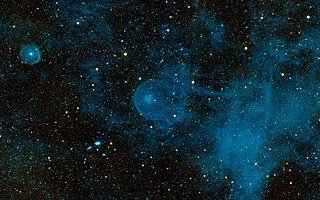
CW Leonis or IRC +10216 is a carbon star that is embedded in a thick dust envelope. It was first discovered in 1969 by a group of astronomers led by Eric Becklin, based upon infrared observations made with the 62 inches (1.6 m) Caltech Infrared Telescope at Mount Wilson Observatory. Its energy is emitted mostly at infrared wavelengths. At a wavelength of 5 μm, it was found to have the highest flux of any object outside the Solar System.

A debris disk, or debris disc, is a circumstellar disk of dust and debris in orbit around a star. Sometimes these disks contain prominent rings, as seen in the image of Fomalhaut on the right. Debris disks are found around stars with mature planetary systems, including at least one debris disk in orbit around an evolved neutron star. Debris disks can also be produced and maintained as the remnants of collisions between planetesimals, otherwise known as asteroids and comets.
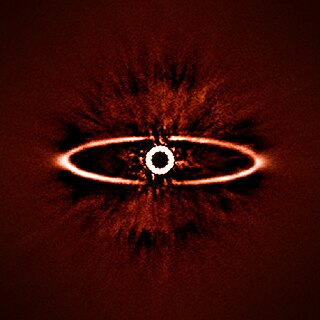
HR 4796 is a binary star system in the southern constellation of Centaurus. Parallax measurements put it at a distance of 235 light-years from the Earth. The two components of this system have an angular separation of 7.7 arcseconds, which, at their estimated distance, is equivalent to a projected separation of about 560 Astronomical Units (AU), or 560 times the separation of the Earth from the Sun. The star and its ring resemble an eye, and it is sometimes known by the nickname "Sauron's Eye".

VY Canis Majoris is an extreme oxygen-rich (O-rich) red hypergiant (RHG) or red supergiant (RSG) and pulsating variable star 1.2 kiloparsecs from the Solar System in the slightly southern constellation of Canis Major. It is one of the largest known stars, one of the most luminous and massive red supergiants, and one of the most luminous stars in the Milky Way.
Scott Jay Kenyon is an American astrophysicist. His work has included advances in symbiotic and other types of interacting binary stars, the formation and evolution of stars, and the formation of planetary systems.
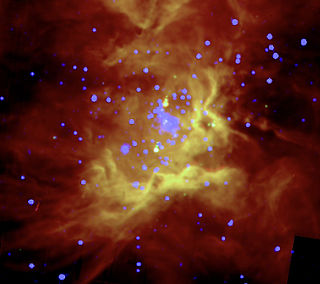
RCW 36 is an emission nebula containing an open cluster in the constellation Vela. This H II region is part of a larger-scale star-forming complex known as the Vela Molecular Ridge (VMR), a collection of molecular clouds in the Milky Way that contain multiple sites of ongoing star-formation activity. The VMR is made up of several distinct clouds, and RCW 36 is embedded in the VMR Cloud C.
HD 193664 a star in the northern constellation of Draco. HD 193664 is its Henry Draper Catalogue designation. With an apparent magnitude of 5.93, according to the Bortle Scale it is visible to the naked eye from suburban skies. Parallax measurements yield an estimated distance of 57 light years. It has a relatively large proper motion of 0.558 arc seconds per year across the sky, and is drifting closer to the Sun with a radial velocity of −4.7 km/s.
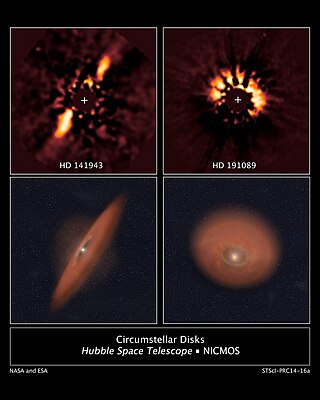
A circumstellar disc is a torus, pancake or ring-shaped accretion disk of matter composed of gas, dust, planetesimals, asteroids, or collision fragments in orbit around a star. Around the youngest stars, they are the reservoirs of material out of which planets may form. Around mature stars, they indicate that planetesimal formation has taken place, and around white dwarfs, they indicate that planetary material survived the whole of stellar evolution. Such a disc can manifest itself in various ways.
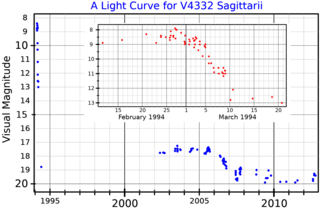
V4332 Sagittarii is a nova-like event in the constellation of Sagittarius. It was discovered February 24, 1994 at an apparent visual magnitude of 8.9 by Japanese amateur astronomer Minoru Yamamoto from Okazaki, Aichi, then confirmed by K. Hirosawa. Initially designated Nova Sagittarii 1994 #1, it was given the variable star designation V4332 Sgr. A spectra of the event taken March 4 lacked the characteristic features of a classical nova, with the only emission lines being of the Balmer series. Subsequent spectra showed a rapid decline in luminosity and a change of spectral type over a period of five days. By 2003, the object was ~1500 times less luminous than at peak magnitude and showed a spectrum of an M-type star.

EP Aquarii is a semiregular variable star in the equatorial constellation of Aquarius. At its peak brightness, visual magnitude 6.37, it might be faintly visible to the unaided eye under ideal observing conditions. A cool red giant on the asymptotic giant branch (AGB), its visible light brightness varies by about 1/2 magnitude over a period of 55 days. EP Aquarii has a complex circumstellar envelope (CSE), which has been the subject of numerous studies.
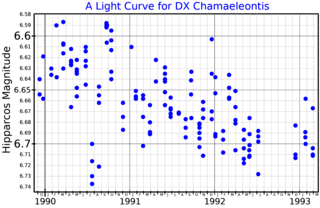
HD 104237 is a candidate multiple star system in the southern constellation of Chamaeleon. It has the variable star designation DX Chamaeleontis, abbreviated DX Cha; HD 104237 is the stellar designation from the Henry Draper Catalogue. The system is dimly visible to the naked eye with an apparent visual magnitude that ranges from 6.59 down to 6.70. It is located at a distance of approximately 348 light-years from the Sun based on parallax measurements. The system is positioned just 2′ to the north-east of the 5th magnitude star Epsilon Chamaeleontis, and is a member of the ε Cha association of co-moving stars.
References
- ↑ Leao; Patrick De Laverny; Mekarnia; De Medeiros; Benoit Vandame (2007). "The circumstellar envelope of IRC+10216 from milli-arcsecond to arcmin scales". Astronomy & Astrophysics. 455 (1): 187–194. arXiv: astro-ph/0703390 . Bibcode:2006A&A...455..187L. doi:10.1051/0004-6361:20054577.
- ↑ Leslie Looney; Lee Mundy; Jack Welch (2003). "Envelope Emission in Young Stellar Systems, A Sub-Arcsecond Survey of Circumstellar Structure". The Astrophysical Journal. 592 (1): 255–265. arXiv: astro-ph/0303640 . Bibcode:2003ApJ...592..255L. doi:10.1086/375582.
